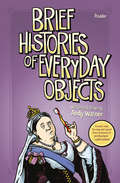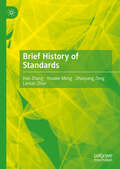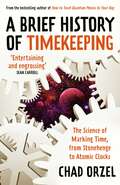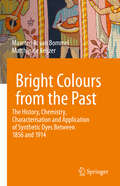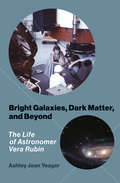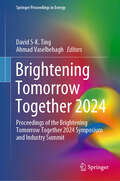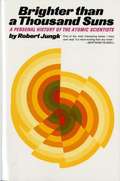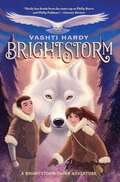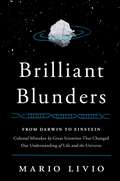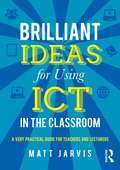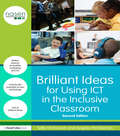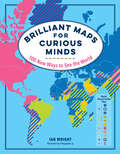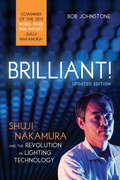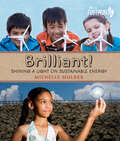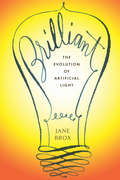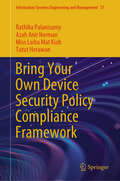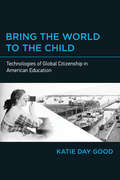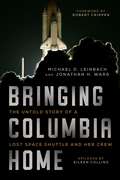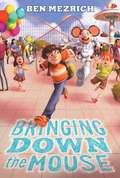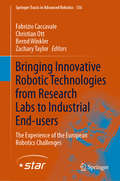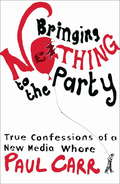- Table View
- List View
Bridging the Strait: The Story of The Confederation Bridge Project
by Copthorne MacdonaldJune 1997 marked the opening of the Confederation Bridge which spans the Northumberland Strait and connects Prince Edward Island to New Brunswick. The bridge, designed and built by the international consortium Strait Crossing, is one of the most innovative engineering projects undertaken in Canada. It is the longest bridge ever constructed over ice covered water and one of the longest continuous multi-span bridges in the world. Bridging the Strait describes the arduous trips taken by ice boats, ferries, steamers and ice breakers which have been the link to PEI. The author, Copthorne Macdonald, traces the events leading up to the building of the bridge. He explains the problems faced by the Strait Crossing team, and tells the story of how they overcame challenging obstacles such as ice, wind and treacherous ocean currents. The stunning achievement of the Confederation Bridge is celebrated in this handsome book. It highlights the contribution of Strait Crossing, and Public Works Canada, who steered the project from conception to completion, and it provides a fitting tribute to the engineers and designers who solved the technical problems and the workers who sacrificed to bring the project to fruition.
Brief Histories of Everyday Objects
by Andy WarnerNOW A NEW YORK TIMES BESTSELLER Hilarious, entertaining, and illustrated histories behind some of life's most common and underappreciated objects - from the paperclip and the toothbrush to the sports bra and roller skatesBrief Histories of Everyday Objects is a graphic tour through the unusual creation of some of the mundane items that surround us in our daily lives. Chapters are peppered with ballpoint pen riots, cowboy wars, and really bad Victorian practical jokes. Structured around the different locations in our home and daily life—the kitchen, the bathroom, the office, and the grocery store—award-nominated illustrator Andy Warner traces the often surprising and sometimes complex histories behind the items we often take for granted. Readers learn how Velcro was created after a Swiss engineer took his dog for a walk; how a naval engineer invented the Slinky; a German housewife, the coffee filter; and a radical feminist and anti-capitalist, the game Monopoly. This is both a book of histories and a book about histories. It explores how lies become legends, trade routes spring up, and empires rise and fall—all from the perspective of your toothbrush or toilet.
Brief History of Standards
by Hao Zhang Youwei Meng Zhaoyang Zeng Lanlan ZhaoThis book takes the technological revolution and industrial changes as the background. The timeline uses the timeline to explain the path of changes in standard concepts since the millennium, showing the scientific system and gradually becoming the focus of the people. This book refers to the classics of a number of standard theories, introduces a number of standards and its theoretical content, and combines the industrial observation experience and typical cases accumulated by the author to put forward opinions on standards and standardization. As the awareness of standards gradually rooted in people's hearts, this book is not only an undergraduate reading, which meets the attention of readers, but also has some appeals to the academic, industry, and business circles to provide reference for the development of world standards.
Brief History of Timekeeping: The Science of Marking Time, from Stonehenge to Atomic Clocks
by Chad Orzel&‘Entertaining and engrossing&’ Sean Carroll Press the snooze button on your alarm once too often and you soon remember the importance of good timekeeping. That need to tell the time connects you to over five thousand years of human history, from the first solstice markers at Newgrange to quartz crystal oscillating in your watch today. Science underpins time: measuring the movement of Sun, Earth and Moon, and unlocking the mysteries of quantum mechanics and relativity theory – the key to ultra-precise atomic clocks. Yet time is also socially decided: the Gregorian calendar we use today came out of fraught politics, while the ancient Maya used sophisticated astronomical observations to produce a calendar system unlike any other. In his quirky and accessible style, Chad Orzel reveals the wondrous physics that makes time something we can set, measure and know.
Brief Notes in Advanced DSP: Fourier Analysis with MATLAB
by Artyom M. Grigoryan Merughan GrigoryanBased on the authors’ research in Fourier analysis, Brief Notes in Advanced DSP: Fourier Analysis with MATLAB® addresses many concepts and applications of digital signal processing (DSP). The included MATLAB® codes illustrate how to apply the ideas in practice.The book begins with the basic concept of the discrete Fourier transformation and its properties. It then describes lifting schemes, integer transformations, the discrete cosine transform, and the paired transform method for calculating the discrete Hadamard transform. The text also examines the decomposition of the 1D signal by so-called section basis signals as well as new forms of 2D signal/image representation and decomposition by direction signals/images. Focusing on Fourier transform wavelets and Givens–Haar transforms, the last chapter discusses the problem of signal multiresolution.This book presents numerous interesting problems and concepts of unitary transformations, such as the Fourier, Hadamard, Hartley, Haar, paired, cosine, and new signal-induced transformations. It aids readers in using new forms and methods of signals and images in the frequency and frequency-and-time domains.
Bright Colours from the Past: The History, Chemistry, Characterisation and Application of Synthetic Dyes Between 1856 and 1914 (Cultural Heritage Science)
by Matthijs de Keijzer Maarten R. van BommelThe invention of Mauveine by Perkin in 1856 led to a revolution in the world of textile dyeing. In the second half of the 19th century, natural dyes were quickly replaced by newly developed synthetic dyes which resulted in a bright palette of colours. The synthetic dyes were not only cheaper to produce, but also easier to apply on textiles due to new dyeing mechanisms. As a result, production costs decreased tremendously and brilliantly dyed textiles became available to the larger public. The introduction of synthetic dyes had a strong impact in fashion; in addition, these colourants were also used as stains on furniture, as inks and in paints. In this publication, the development of these vivid colourants is presented. It brings together information about the history of synthetic dyes, including the first attempts, the so-called semi-synthetic dyes, and presenting the most relevant dyes and dye classes, such as nitro dyes, tri-arylmethanes, azo dyes, xanthenes, sulfur dyes, synthetic alizarin and synthetic indigo. It contains a wealth of information regarding the numerous synonyms, trade names, manufacturers and patents. International trade and competition, which was fierce, are discussed. The chemistry behind the synthetic dyeing is explained, including new dyeing technologies developed. The application of dyes and their fastness properties are also presented. An overview of analytical techniques used for characterisation is given. Many case studies are included, expressing the importance of the dyes and the creativity of mankind when applying these colourants. As such, this publication can be seen as a colourful journey through history, relevant for conservators, curators, historians, chemists and all who are interested in the history and development of synthetic dyes.
Bright Dreams: The Brilliant Inventions of Nikola Tesla
by Tracy DockrayYoung Nikola Tesla got a shock when he rubbed his cat's fur. That small spark lit his imagination forever. Covering his early years to his eventual success in the world of electricity, Bright Dreams showcases Tesla's incredible journey of discovery and perseverance. Author-illustrator Tracy Dockray conveys Tesla's busy and imaginative world with collage-style artwork and informative sidebars.
Bright Galaxies, Dark Matter, and Beyond: The Life of Astronomer Vera Rubin
by Ashley Jean YeagerHow Vera Rubin convinced the scientific community that dark matter might exist, persevering despite early dismissals of her work. We now know that the universe is mostly dark, made up of particles and forces that are undetectable even by our most powerful telescopes. The discovery of the possible existence of dark matter and dark energy signaled a Copernican-like revolution in astronomy: not only are we not the center of the universe, neither is the stuff of which we&’re made. Astronomer Vera Rubin (1928–2016) played a pivotal role in this discovery. By showing that some astronomical objects seem to defy gravity&’s grip, Rubin helped convince the scientific community of the possibility of dark matter. In Bright Galaxies, Dark Matter, and Beyond, Ashley Jean Yeager tells the story of Rubin&’s life and work, recounting her persistence despite early dismissals of her work and widespread sexism in science. Yeager describes Rubin&’s childhood fascination with stars, her education at Vassar and Cornell, and her marriage to a fellow scientist. At first, Rubin wasn&’t taken seriously; she was a rarity, a woman in science, and her findings seemed almost incredible. Some observatories in midcentury America restricted women from using their large telescopes; Rubin was unable to collect her own data until a decade after she had earned her PhD. Still, she continued her groundbreaking work, driving a scientific revolution. She received the National Medal of Science in 1993, but never the Nobel Prize—perhaps overlooked because of her gender. She&’s since been memorialized with a ridge on Mars, an asteroid, a galaxy, and most recently, the Vera C. Rubin Observatory—the first national observatory named after a woman.
Brightening Tomorrow Together 2024: Proceedings of the Brightening Tomorrow Together 2024 Symposium and Industry Summit (Springer Proceedings in Energy)
by David S-K. Ting Ahmad VaselbehaghThis book includes the proceedings of the Symposium and Industry Summit, June 20-21, 2024 at University of Windsor Negativity and pessimism seem to dominate the media in recent years, overshadowing the bright side of our beautiful planet and disheartening its inhabitants. Not to deny the prevailing challenges, but tomorrow is far from complete ruin and doom. Brightening Tomorrow Together aims at bringing optimists from many disciplines of expertise and walks of life together to synergise existing know-how and further the latest technologies and measures to hasten the brightening of tomorrow. This book is part of the big dream of the Turbulence and Energy Laboratory. It strives to bring together a diverse group to exchange state-of-the-art progresses and to promote collaborations across different disciplines to hasten the brightening of tomorrow together. Topics of interest include engineering cleaner energy, improving our understandings of water and wastewater, reducing waste and pollution at all fronts, and actualizing eco-friendly agriculture and living.
Brighter Than a Thousand Suns: A Personal History of the Atomic Scientists
by Robert Jungk James CleughAn account of the remarkable scientists who discovered that nuclear fission was possible and then became concerned about its implications. Index. Translated by James Cleugh.
Brightstorm: A Sky-ship Adventure (Brightstorm #1)
by Vashti HardyCritically acclaimed in the UK, Brightstorm is a fast-paced fantasy adventure novel that will set imaginations soaring. Arthur and Maudie Brightstorm receive devastating news: their famous explorer father has died in a failed attempt to reach South Polaris. To make matters worse, the Lontown Geographical Society finds Ernest Brightstorm guilty of sabotaging the expedition of his competitor, Eudora Vane. But a mysterious clue leads the twins to question the story they’ve been told—and to uncover the truth, they must undertake the journey of a lifetime. Joining the ragtag crew of a homemade sky-ship captained by the intrepid Harriet Culpepper, Arthur and Maudie race to South Polaris to salvage their family’s reputation and find out what really happened on their father’s doomed expedition. Brightstorm is a propulsive and compelling fantasy adventure set among the vibrant landscapes and dynamic characters of Vashti Hardy’s vividly imagined world.
Brilliant Blunders: From Darwin to Einstein - Colossal Mistakes by Great Scientists That Changed Our Understanding of Life and the Universe
by Mario LivioDrawing on the lives of five great scientists, this “scholarly, insightful, and beautifully written book” (Martin Rees, author of From Here to Infinity) illuminates the path to scientific discovery.Charles Darwin, William Thomson (Lord Kelvin), Linus Pauling, Fred Hoyle, and Albert Einstein all made groundbreaking contributions to their fields—but each also stumbled badly. Darwin’s theory of natural selection shouldn’t have worked, according to the prevailing beliefs of his time. Lord Kelvin gravely miscalculated the age of the earth. Linus Pauling, the world’s premier chemist, constructed an erroneous model for DNA in his haste to beat the competition to publication. Astrophysicist Fred Hoyle dismissed the idea of a “Big Bang” origin to the universe (ironically, the caustic name he gave to this event endured long after his erroneous objections were disproven). And Albert Einstein speculated incorrectly about the forces of the universe—and that speculation opened the door to brilliant conceptual leaps. As Mario Livio luminously explains in this “thoughtful meditation on the course of science itself” (The New York Times Book Review), these five scientists expanded our knowledge of life on earth, the evolution of the earth, and the evolution of the universe, despite and because of their errors. “Thoughtful, well-researched, and beautifully written” (The Washington Post), Brilliant Blunders is a wonderfully insightful examination of the psychology of five fascinating scientists—and the mistakes as well as the achievements that made them famous.
Brilliant Ideas for Using ICT in the Classroom: A very practical guide for teachers and lecturers
by Matt JarvisBrilliant Ideas for Using ICT in the Classroom is a totally practical, hands-on guide to using ICT in and around the classroom for all secondary school teachers and lecturers in post-compulsory education. Assuming no prior expertise, it centres on software and resources that are free or very low cost, and offers step-by-step guidance and creative ideas to improve the experience and engagement of your students. With a focus on what tools to use, what educational need they satisfy and how to incorporate them into good pedagogy, key topics covered include: Effective use of presentation technologies Using, producing and sharing multimedia Interactive whiteboards and related technologies Using Web 2.0 technologies Mobile learning Supporting diverse student needs through technology. Brilliant Ideas for Using ICT in the Classroom puts equal emphasis on both technical and pedagogical issues, making it the ideal companion whatever your ICT or e-learning needs. Catering equally well for Windows, Mac and Linux users, this book is designed to give you all the confidence you need to start teaching brilliantly with ICT.
Brilliant Ideas for Using ICT in the Inclusive Classroom (David Fulton / Nasen Ser.)
by Sally McKeown Angela McGlashonRunner up in Teach Secondary’s Technology and Innovation Awards 2014 sponsored by Lego, Brilliant Ideas for using ICT in the Inclusive Classroom provides lots of simple practical ideas showing teachers and support staff how they can use ICT to boost the achievement of all pupils. How can you use ICT to boost the achievement of all your pupils? This practical teachers’ guide will help you to unlock the enormous potential of new technology in order to enhance pupils’ learning, particularly for young people with additional needs. Written by two of the UK’s leading technology experts, this invaluable and newly updated resource will enable you to use ICT effectively to make lessons more accessible, motivating and fun. With fifty illustrated case studies and twenty starter activities, this practical resource will help you to introduce new technology into the inclusive classroom. It has been specifically designed to help develop your pupils’ key skills, such as problem solving, developing concepts and communicating to different audiences. In each activity, the authors show why and how a particular resource was used and show how similar techniques can be implemented to open up the curriculum to your learners. The authors include timely and realistic advice on how to use a range of technologies from the cheap and cheerful – and even free – to more sophisticated and specialist packages. Find out about: Apps Blogging Digital animation Podcasting Digital storytelling Wikis Geocaching Coding Games and gaming Sat nav Art packages Twitter Whether you’re already techno-savvy or looking to get started with ICT, this book is full of brilliant ideas on how to engage learners of all abilities using technology. If you’re looking for inspiration on how to integrate creative uses of ICT with the curriculum, this book will prove invaluable.
Brilliant Maps for Curious Minds: 100 New Ways To See The World (Maps for Curious Minds #0)
by Ian WrightA singular atlas of 100 infographic maps from thought-provoking to flat-out fun. And don’t miss the next book in the series, North American Maps for Curious Minds! Publisher’s note: Brilliant Maps for Curious Minds was published in the UK under the title Brilliant Maps. Which countries don’t have rivers? Which ones have North Korean embassies? Who drives on the “wrong” side of the road? How many national economies are bigger than California’s? And where can you still find lions in the wild? You’ll learn answers to these questions and many more in Brilliant Maps for Curious Minds. This one-of-a-kind atlas is packed with eye-opening analysis (Which nations have had female leaders?), whimsical insight (Where can’t you find a McDonald’s?), and surprising connections that illuminate the contours of culture, history, and politics. Each of these 100 maps will change the way you see the world—and your place in it.
Brilliant!
by Bob JohnstoneA revolution in the way we use artificial lighting is underway, one that is every bit as sweeping and significant as Edison's invention of the light bulb. The technology of light emitting diodes (LEDs) is ready for widespread implementation. Its impacts will include a reduction in energy consumption for electric lighting by up to 80 percent.Brilliant! tells the story of Shuji Nakamura, a gifted Japanese engineer who came out of nowhere to stun the world with his announcement that he had created the last piece in the puzzle needed for manufacturing solid-state white lights. The invention of this holy-grail product, which promises to make Edison's light bulb obsolete, had eluded the best minds at the top electronic firms for twenty-five years. Until his startling announcement, Nakamura had not even been on the radar screen of most industry observers. Veteran technology writer Bob Johnstone traces the career of Nakamura, which included many years of obstinate individual effort as well as a dramatic legal battle pitting him against his former Japanese employer. Over a five-year span, Nakamura distinguished himself with an unprecedented series of inventions--bright blue, green, ultraviolet, and then white LEDs, plus a blue laser that will play an essential role in the next-generation DVD players. Then he was forced to leave Nichia Chemical, the company where he had worked for twenty years, and his former employer sued him. The result was a multimillion-dollar settlement in a landmark decision that acknowledged, for the first time, the rights of individual inventors working in a corporate context. Today, Nakamura holds a professor's chair at the University of California at Santa Barbara, where he continues to develop the technology of LEDs. Johnstone, the first Western journalist to meet and interview Nakamura, has received the brilliant engineer's full cooperation through a series of exclusive interviews given for the book. Johnstone has also interviewed other key players in the imminent lighting revolution, providing an exciting preview of the technological, entrepreneurial, and artistic creativity that will soon be unleashed by Nakamura's inventions.
Brilliant!: Shining a light on sustainable energy (Orca Footprints #3)
by Michelle MulderDid you know that cars can run on french-fry grease or that human poop can be used to provide power to classrooms? Brilliant! is about what happens when you harness the power of imagination and innovation: the world changes for the better! Kids in Mexico help light up their houses by playing soccer, and in the Philippines, pop-bottle skylights are improving the quality of life for thousands of families. Full of examples of unusual (and often peculiar) power sources, Brilliant! encourages kids to look around for new and sustainable ways to light up the world.
Brilliant: The Evolution of Artificial Light
by Jane BroxThis &“superb history&” of artificial light traces the evolution of society—&“invariably fascinating and often original . . . [it] amply lives up to its title&” (Publishers Weekly, starred review). In Brilliant, Jane Brox explores humankind&’s ever-changing relationship to artificial light, from the stone lamps of the Pleistocene to the LEDs embedded in fabrics of the future. More than a survey of technological development, this sweeping history reveals how artificial light changed our world, and how those social and cultural changes in turn led to the pursuit of more ways of spreading, maintaining, and controlling light. Brox plumbs the class implications of light—who had it, who didn&’t—through the centuries when crude lamps and tallow candles constricted waking hours. She identifies the pursuit of whale oil as the first time the need for light thrust us toward an environmental tipping point. Only decades later, gas street lights opened up the evening hours to leisure, which changed the ways we live and sleep and the world&’s ecosystems. Edison&’s bulbs produced a light that seemed to its users all but divorced from human effort or cost. And yet, as Brox&’s informative portrait of our current grid system shows, the cost is ever with us. Brilliant is infused with human voices, startling insights, and timely questions about how our future lives will be shaped by light
Bring Your Own Device Security Policy Compliance Framework (Information Systems Engineering and Management #37)
by Tutut Herawan Rathika Palanisamy Azah Anir Norman Miss Laiha KiahProliferation of Bring Your Own Device (BYOD) has instigated a widespread change, fast outpacing the security strategies deployed by organizations. The influx of these devices has created information security challenges within organizations, further exacerbated with employees&’ inconsistent adherence with BYOD security policy. To prevent information security breaches, compliance with BYOD security policy and procedures is vital. This book aims to investigate the factors that determine employees' BYOD security policy compliance by using mixed methods approach. Security policy compliance factors, BYOD practices and security risks were identified following a systematic review approach. Building on Organizational Control Theory, Security Culture and Social Cognitive Theory, a research framework positing a set of plausible factors determining BYOD security policy compliance was developed. Next, with a purposive sample of eight information security experts from selected public sector organizations, interviews and BYOD risk assessments analysis were performed to furnish in-depth insights into BYOD risks, its impact on organizations and recommend control measures to overcome them. This led to the suggestion of four control measures to mitigate critical BYOD security risks such as Security Training and Awareness (SETA), policy, top management commitment and technical countermeasures. The control measures were mapped into the research framework to be tested in the following quantitative phase. The proposed research framework was tested using survey results from 346 employees of three Critical National Information Infrastructure (CNII) agencies. Using Partial Least Squares – Structural Equation Modelling (PLS-SEM), the framework's validity and reliability were evaluated, and hypotheses were tested. Findings show that perceived mandatoriness, self-efficacy and psychological ownership are influential in predicting employees&’ BYOD security policy compliance. Specification of security policy is associated with perceived mandatoriness, while BYOD IT support and SETA are significant towards self-efficacy. Unexpectedly, security culture has been found to have no significant relationship to BYOD security policy compliance. Theoretical, practical, and methodological contributions were discussed and suggestions for future research were recommended. The analysis led to a number of insightful findings that contribute to the literature and the management, which are predominantly centered on traditional computing. In view of the ever-increasing BYOD threats to the security of government information, it is imperative that IT managers establish and implement effective policies to protect vital information assets. Consequently, the findings of this study may benefit policymakers, particularly in the public sector, in their efforts to increase BYOD security policy compliance among employees.
Bring the World to the Child: Technologies of Global Citizenship in American Education (The\mit Press Ser.)
by Katie Day GoodHow, long before the advent of computers and the internet, educators used technology to help students become media-literate, future-ready, and world-minded citizens.Today, educators, technology leaders, and policy makers promote the importance of “global,” “wired,” and “multimodal” learning; efforts to teach young people to become engaged global citizens and skilled users of media often go hand in hand. But the use of technology to bring students into closer contact with the outside world did not begin with the first computer in a classroom. In this book, Katie Day Good traces the roots of the digital era's “connected learning” and “global classrooms” to the first half of the twentieth century, when educators adopted a range of media and materials—including lantern slides, bulletin boards, radios, and film projectors—as what she terms “technologies of global citizenship.”Good describes how progressive reformers in the early twentieth century made a case for deploying diverse media technologies in the classroom to promote cosmopolitanism and civic-minded learning. To “bring the world to the child,” these reformers praised not only new mechanical media—including stereoscopes, photography, and educational films—but also humbler forms of media, created by teachers and children, including scrapbooks, peace pageants, and pen pal correspondence. The goal was a “mediated cosmopolitanism,” teaching children to look outward onto a fast-changing world—and inward, at their own national greatness. Good argues that the public school system became a fraught site of global media reception, production, and exchange in American life, teaching children to engage with cultural differences while reinforcing hegemonic ideas about race, citizenship, and US-world relations.
Bringing Columbia Home: The Untold Story of a Lost Space Shuttle and Her Crew
by Michael Leinbach Jonathan Ward Eileen Collins Robert CrippenFor the first time, here is the definitive inside story of the Columbia disaster and recovery and the inspiring message it ultimately holds. <P><P>In the aftermath of tragedy, people and communities came together to help bring home the remains of the crew and nearly 40 percent of shuttle, an effort that was instrumental in piecing together what happened so the shuttle program could return to flight and complete the International Space Station. <P><P>Bringing Columbia Home shares the deeply personal stories that emerged as NASA employees looked for lost colleagues and searchers overcame immense physical, logistical, and emotional challenges and worked together to accomplish the impossible. <P><P> Featuring a foreword and epilogue by astronauts Robert Crippen and Eileen Collins, and dedicated to the astronauts and recovery search persons who lost their lives, this is an incredible, compelling narrative about the best of humanity in the darkest of times and about how a failure at the pinnacle of human achievement became a story of cooperation and hope.
Bringing Columbia Home: The Untold Story of a Lost Space Shuttle and Her Crew
by Jonathan H. Ward Eileen Collins Robert Crippen Michael D. LeinbachTimed to release for the 15th Anniversary of the Columbia space shuttle disaster, this is the epic true story of one of the most dramatic, unforgettable adventures of our time.On February 1, 2003, Columbia disintegrated on reentry before the nation’s eyes, and all seven astronauts aboard were lost. Author Mike Leinbach, Launch Director of the space shuttle program at NASA’s John F. Kennedy Space Center was a key leader in the search and recovery effort as NASA, FEMA, the FBI, the US Forest Service, and dozens more federal, state, and local agencies combed an area of rural east Texas the size of Rhode Island for every piece of the shuttle and her crew they could find. Assisted by hundreds of volunteers, it would become the largest ground search operation in US history. This comprehensive account is told in four parts: Parallel Confusion Courage, Compassion, and Commitment Picking Up the Pieces A Bittersweet VictoryFor the first time, here is the definitive inside story of the Columbia disaster and recovery and the inspiring message it ultimately holds. In the aftermath of tragedy, people and communities came together to help bring home the remains of the crew and nearly 40 percent of shuttle, an effort that was instrumental in piecing together what happened so the shuttle program could return to flight and complete the International Space Station. Bringing Columbia Home shares the deeply personal stories that emerged as NASA employees looked for lost colleagues and searchers overcame immense physical, logistical, and emotional challenges and worked together to accomplish the impossible.Featuring a foreword and epilogue by astronauts Robert Crippen and Eileen Collins, and dedicated to the astronauts and recovery search persons who lost their lives, this is an incredible, compelling narrative about the best of humanity in the darkest of times and about how a failure at the pinnacle of human achievement became a story of cooperation and hope.
Bringing Down the Mouse
by Ben MezrichCharlie Lewis goes on a roller coaster ride of risk, math, and gaming in this middle grade novel that parallels the New York Times bestselling Bringing Down the House, which inspired the movie 21 with Kevin Spacey.Charlie Lewis is a nerd. All he's ever been good at is math--and he's really good at math. So good that he's recruited by a group of kids determined to game the system at the biggest theme park in the world--and win the grand prize. Soon Charlie is caught up in the excitement and thrill of using his math skills for awesomeness...but what's at stake may be more than he's willing to risk. How far will Charlie go for a chance at the ultimate reward?
Bringing Innovative Robotic Technologies from Research Labs to Industrial End-users: The Experience of the European Robotics Challenges (Springer Tracts in Advanced Robotics #136)
by Fabrizio Caccavale Zachary Taylor Christian Ott Bernd WinklerThis book presents the main achievements of the EuRoC (European Robotics Challenges) project, which ran from 1st January,2014 to 30th June 2018 and was funded by the European Union under the 7th Framework Programme. It describes not only the scientific and technological achievements of the project, but also the potential of the comparative challenge approach in robotics for knowledge advancement and technology transfer.
Bringing Nothing to the Party: True Confessions Of A New Media Whore
by Paul CarrA fascinating and hilarious expose of how a group of young opportunists, chancers and geniuses found instant fame and fortune by messing about on the web. And one man's attempt to follow in their footsteps.Having covered the first dot com boom, and founded a web-to-print publishing business during the second one, Paul counts many of the leading Internet entrepreneurs amongst his closest friends. These friendships mean he doesn't just attend their product launches and press conferences and speak at their events, but also gets invited to their ultra-exclusive networking events, and gets drunk at their parties.Paul has enjoyed this bizarre world of excess without having to live in it. To help the moguls celebrate raising millions of pounds of funding without having to face the wrath of the venture capitalists himself. But in 2006, Paul decided he didn't want to be a spectator any more. He had been harbouring a great dot com project of his own and decided it was time to do something about it.

